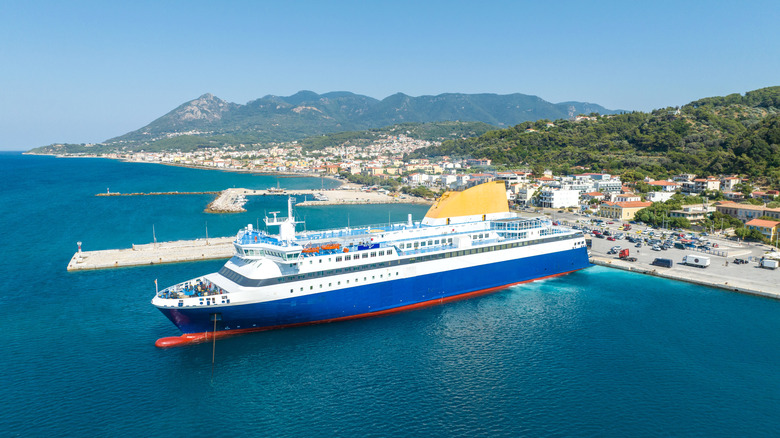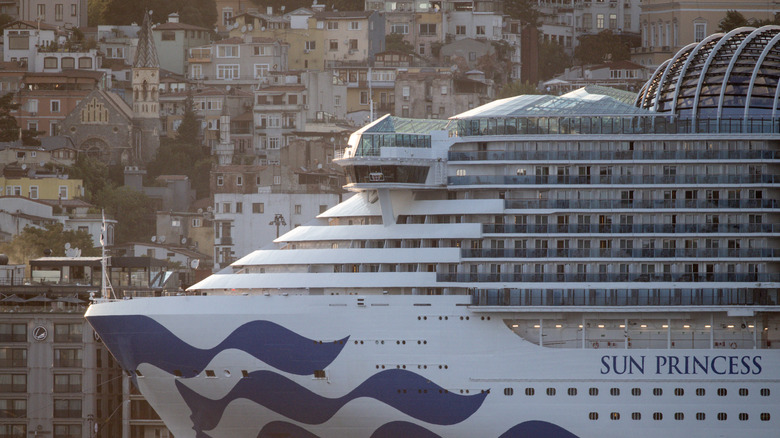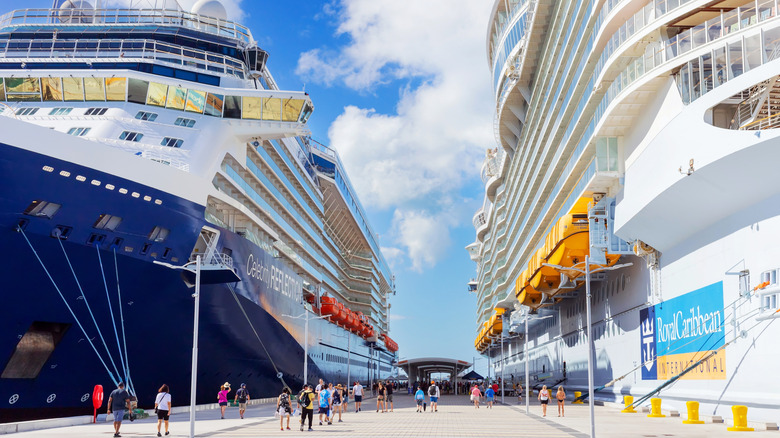Climate Change Impacts Cruising In Ways You May Not Have Ever Imagined
It's sometime in the future, and you're cruising to Antarctica. You're expecting to see thousands of penguins sliding down snow-covered slopes, whales breaching in frigid waters, and brilliant-white icebergs — nature's sculptures arising from the ocean depths. Except ... you don't. Wildlife is scant, and the populous colonies you anticipated have vanished. There's no sea ice dotting the passage, and the icebergs have mostly melted away. This isn't Antarctica yet — but it could be if climate change continues unimpeded.
Climate change is defined by the United Nations as "long-term shifts in temperatures and weather patterns," and the international body asserts that humans are primarily responsible. This has far-reaching effects that touch every nation and industry, and cruising has seen some already: Booking trends and itineraries have changed significantly, with cruising seasons shifting for certain destinations. While a sun-soaked summer cruise in the Mediterranean used to be the status quo, fall and spring departures are now more popular. The excessive heat, along with overcrowding, is one of the reasons so many cruise lines head to the Mediterranean in the winter. Meanwhile, in the Arctic and Antarctica, ships can now pass through or stop in once-inaccessible areas due to receding glaciers. However, the sea ice and the animals that depend on it are a primary reason to visit, so tourism may decline there in the future.
More alarming will be the impact on the environments where ships stop. Passengers cruise to see places of natural beauty and interact with exotic animals. However, the populations of many species — including the African elephant and polar bear — are shrinking as their habitats are wiped out and food becomes scarce. As well, rising temperatures and increasing natural disasters can destroy fragile and sensitive ecosystems, particularly coral reefs — meaning that there might be little to see underwater on your next snorkeling trip.
Cruise liners' contribution to climate change
One culprit of climate change's steady onslaught is certainly cruising itself. Indeed, the seafarers of yore would be shocked at today's behemoth ships. In the early 1900s, vessels were streamlined and functional, with the sole purpose of transporting people to their destination quickly. However, nowadays, vessels have become floating luxury resorts, prioritizing customer comfort above all else. From the gargantuan Icon of the Seas, the world's largest cruise ship, to the Carnival Jubilee, with the world's first ocean roller coaster, every company seems to be in a neck-to-neck race to provide the most jaw-dropping experience possible. This comes at a cost: Cruising's unprecedented popularity brings in hordes of tourists to once-remote places, polluting the area and devastating pristine environments.
According to The Guardian, 25% of all ocean waste is produced by cruises, despite only representing 1% of the world's commercial fleets. In 2022 alone, the 218 vessels operating out of Europe emitted more sulfur oxides than the entire continent's cars combined — and this doesn't factor in the plastics, chemicals, sewage, and other forms of waste dumped. Their environmental impact is just one of the unsettling reasons you may want to avoid taking a cruise.
However, there are certain reforms that cruise lines can and should be taking. These include investing in alternative fuels, energy-efficient propulsion systems, and battery-powered vessels; developing advanced wastewater treatment systems; switching to renewable energy sources; and hiring climate scientists and sustainability experts as advisors. Cruisers themselves can also take actions to push companies in the right direction and limit their own impact. While it's impossible to turn back the clock on climate change, of which some consequences are irreversible, it's still possible to slow its course — and this doesn't necessarily mean giving up travel, or even cruising, entirely.
How cruisers can take action for the environment
It can't be denied that cruises — even greener ones — have an outsized effect on the ocean, land, and air. So, if you're a frequent cruiser taking multiple voyages annually, exchanging one of these trips for land-based, slow travel can reduce your environmental impact. Additionally, you can avoid the mega-ships that come with a plethora of amenities like water parks, rides, cinemas, and more. A vessel's facilities alone account for up to 40% of its energy usage (via Sintef), so if you're simply looking to explore new places in a relaxing atmosphere, you probably don't need all these bells and whistles.
When cruise lines commit to measures like zero-emission docking or when they upgrade to more environmentally-friendly vessels, show your support through loyalty, letters, or social media posts. The harsh reality is that corporate decisions are often based on sales and public image rather than good intentions — so if a company chooses to implement green policies and its customer base doesn't seem to care, it may be inclined to reverse them later or take no further actions, especially if they negatively impact its bottom line.
Is it possible to find a 100% clean cruise? The answer, unfortunately, is no. However, not all cruises are the same, as the 2024 Cruise Ship Report Card, created by Friends of the Earth, shows. It graded 21 cruise lines from A to F on four environmental factors: sewage treatment, air pollution reduction, water quality, and transparency. The top marks went to Hurtigruten (B+), HX | Hurtigruten Expeditions (B+), and Disney Cruises Line (B), with all others graded C+ or worse. If sea-voyaging with a lower impact is important to you, make a conscious choice to book with more eco-friendly, less damaging lines in the future.


